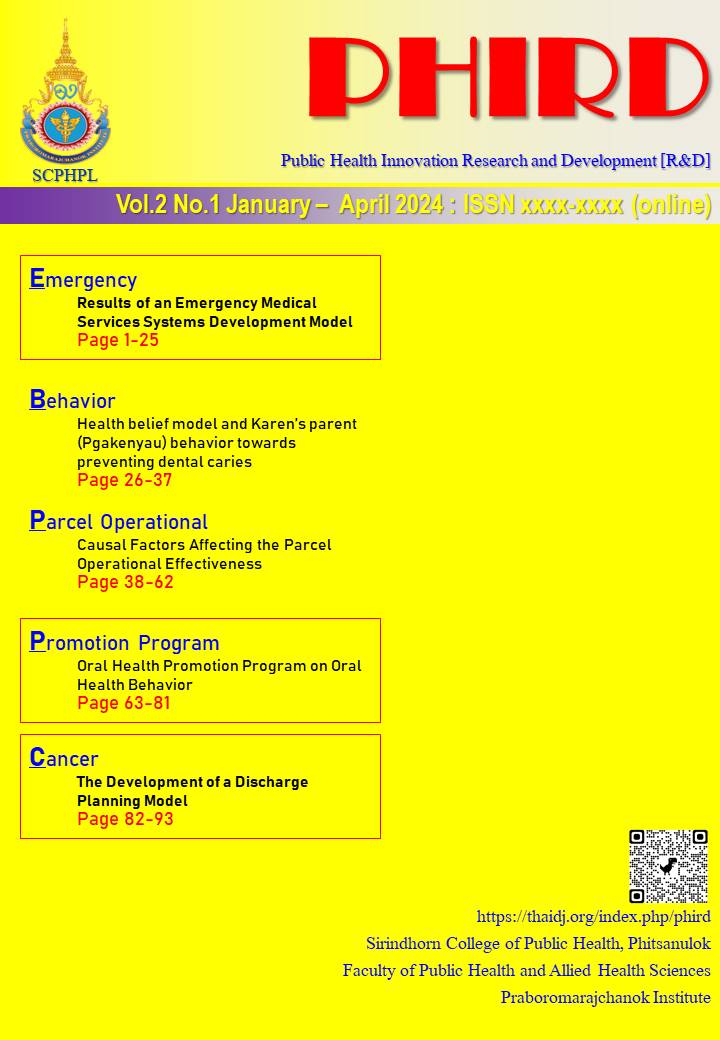ประสิทธิผลของโปรแกรมการส่งเสริมสุขภาพช่องปากต่อพฤติกรรมการดูแลสุขภาพช่องปากของนักเรียนอายุ 12 ปี
คำสำคัญ:
โปรแกรมการส่งเสริมสุขภาพช่องปาก, พฤติกรรมการดูแลสุขภาพช่องปาก, ปริมาณคราบจุลินทรีย์, นักเรียนอายุ 12 ปีบทคัดย่อ
ความเป็นมา ปัญหาฟันผุและสุขภาพช่องปาก ยังคงเป็นปัญหาทางด้านทันตสาธารณสุขในทุกๆ ระดับ ไปจนถึงระดับโลก โดยบุคลากรที่เกี่ยวข้องได้พยายามแก้ปัญหาในหลายๆ รูปแบบ แต่ก็ได้ผลเพียงบางส่วน
วัตถุประสงค์การวิจัย เพื่อศึกษาประสิทธิผลของโปรแกรมการส่งเสริมสุขภาพช่องปากต่อพฤติกรรมการดูแลสุขภาพช่องปากของนักเรียนอายุ 12 ปี การวิจัยถูกดำเนินการใน 3 ขั้นตอน คือ 1) การสร้างและศึกษาคุณภาพโปรแกรม 2) การทดลองและศึกษาผลการใช้โปรแกรม 3) ศึกษาความพึงพอใจที่มีต่อการใช้รูปแบบ
วิธีการดำเนินการวิจัย ใช้รูปแบบการวิจัยแบบกึ่งทดลอง เลือกกลุ่มตัวอย่างแบบเจาะจง โดยเลือกโรงเรียนที่มีคุณสมบัติคล้ายกัน 2 โรงเรียน จากนั้นสุ่ม เลือกนักเรียนที่มีอายุ 12 ปีที่กำลังศึกษาอยู่ในชั้นประถม ศึกษาปีที่ 5 และชั้นประถมศึกษาปีที่ 6 เขตพื้นที่อำเภอวัดโบสถ์ จังหวัดพิษณุโลก โรงเรียนละ 30 คน เพื่อเป็นกลุ่มทดลองและกลุ่มควบคุม กลุ่มทดลองได้รับโปรแกรม และกลุ่มควบคุมได้ รับการให้ทันตสุขศึกษาตามปกติ การเก็บรวบรวมข้อมูล กระทำ 2 ครั้ง คือก่อนการทดลองและหลังการทดลองโดยใช้แบบสำรวจ ความรู้ ทัศนคติ และพฤติกรรมการดูแลสุขภาพช่องปาก และแบบบันทึกการตรวจคราบจุลินทรีย์ วิเคราะห์ข้อมูลด้วย สถิติเชิงพรรณนา ได้แก่ ร้อยละ ค่าเฉลี่ย ค่าเบี่ยงเบนมาตรฐาน และสถิติเชิงอนุมาน
ผลการวิจัย 1) ผลการสร้างและตรวจสอบโปรแกรม พบว่า โปรแกรมมีองค์ประกอบ 5 องค์ประกอบ ได้แก่ หลักการ วัตถุประสงค์ เนื้อหา กระบวนการพัฒนาสมรรถนะ และการวัดและประเมินผล และมีคุณภาพดี 2) ผลการศึกษาพบว่าภายหลังการเข้าร่วมโปรแกรม กลุ่มทดลอง มีคะแนนเฉลี่ยความรู้ในการดูแลสุขภาพช่องปาก คะแนนเฉลี่ยทัศนคติในการดูแลสุขภาพช่องปาก และคะแนนเฉลี่ยพฤติกรรมในการดูแลสุขภาพช่องปาก สูงกว่าก่อนการเข้าร่วมโปรแกรมและสูงกว่ากลุ่มควบคุมอย่างมีนัยสำคัญทาง สถิติที่ระดับ 0.05 กลุ่มทดลองมีค่าเฉลี่ยปริมาณคราบจุลินทรีย์ต่ำกว่า ก่อนการเข้าร่วมโปรแกรมและต่ำกว่ากลุ่มควบคุมอย่างมี นัยสำคัญทางสถิติที่ระดับ 0.05 3) มีความพึงพอใจต่อโปรแกรมที่พัฒนาขึ้น อยู่ในระดับมาก
สรุป การศึกษาวิจัยในครั้งนี้สามารถพิสูจน์ให้เห็นว่า โปรแกรมสามารถเพิ่มคะแนนเฉลี่ยความรู้ คะแนนเฉลี่ยทัศนคติ และคะแนนเฉลี่ยพฤติกรรมในการดูแลสุขภาพช่องปาก และสามารถลดค่าเฉลี่ยปริมาณคราบจุลินทรีย์ของนักเรียน อายุ 12 ปีได้
เอกสารอ้างอิง
Bandura A. (1997). Self-efficacy: Toward a unifying theory of behavioral change. PSYCHOL REV, 84(2): 191-215.
Buathong C, Promsiripaiboon Y, Vatchalavivat A. (2015). The Effects of Oral Health Promotion Program on Dental Caries Prevention behaviors of Grade Six Students at Ban Banghean School at Plaipraya District, Krabi Province. J Commun Health Develop KKU, 3(2): 293-306.
Dental Health Division. (2012). The 7th Thailand national oral health survey report. Nontaburi: Department of Health, Ministry of Public Health. 68-9.
Division of Dental Health, Department of Health, Ministry of Public Health. (2012). The 7th National Oral Health Survey Report. Bangkok: Samcharoen Panich.
Greene JC, Vermillion JR. (1964). The Simplified Oral Hygiene Index. JADA, 68: 7-13.
Iamsupasit S. (2006). Theories and techniques in behavior modification. 5th ed. Bangkok: Chulalongkorn University.
Inpun W. (2015). Effect of Dental Health Program to Dental Caries Prevention Behavior among Sixth Grade Students of Anubanprachinburi School. PRRJ, 10(1): 131-142.
Phongpisanu B. (2018). Main Steps of Doing Research and Development in Public Health. Med J Clin Trials Case Stud, 2(10): 000183. DOI: 10.23880/mjccs-16000183
Phongpisanu B. (2019). Techniques for Writing Chapter I of Research and Development in Public Health. Med J Clin Trials Case Stud, 3(4): 000222. DOI: 10.23880/mjccs-16000222
Phongpisanu B. (2020) Process of Research and Development in Public Health. Int J Clin Case Stud Rep, 2(1): 61-65.
Rosphirom S. (2013). The Effectiveness of a Dental Health Education Programme Appying Self- Efficacy Theory on Dental Health Behavior of Prathomsuksa 4 Students in Muang District, Nakronpathom Province. Thesis of Master of Science Degree in Health Education, Graduate School, Srinakharinwirot University.
Tansakul S. (2005). Theories and Models Applied to Health Education and Behavioral Science. 2nd ed. Bangkok: Yutharint Printing.
Phongpisanu, B.. (2021). Main Steps of Doing Research and Development in Public Health: An Observational Study. New Frontiers in Medicine and Medical Research Vol. 14, 80–86. https://doi.org/10.9734/bpi/nfmmr/v14/4289F, https://www.bookpi.org/bookstore/product/new-frontiers-in-medicine-and-medical-research-vol-14/
Phongpisanu, B.. (2021). Techniques of Writing Chapter 1 for Research and Development in Public Health. New Frontiers in Medicine and Medical Research Vol. 14, 65–79. https://doi.org/10.9734/bpi/nfmmr/v14/3839F, https://www.bookpi.org/bookstore/product/new-frontiers-in-medicine-and-medical-research-vol-14/
Phongpisanu B. (2020). A Technique of Modeling in Public Health Research and Development. World Journal of Public Health, 5(4), 2020, pp. 89-98. doi: 10.11648/j.wjph.20200504.13
Phongpisanu B. (2019). Techniques for Writing Chapter I of Research and Development in Public Health. Med J Clin Trials Case Stud, 3(4): 000222. DOI: 10.23880/mjccs-16000222
ดาวน์โหลด
เผยแพร่แล้ว
วิธีการอ้างอิง
ฉบับ
บท
การอนุญาต
ลิขสิทธิ์ (c) 2022 การวิจัยและพัฒนานวัตกรรมสาธารณสุข

This work is licensed under a Creative Commons Attribution-NonCommercial-NoDerivatives 4.0 International License.
This journal is published under the terms of the Creative Commons Attribution 4.0 International (CC-BY-NC-ND 4.0) by Sirindhorn College of Public Health Phitsanulok, Faculty of Public Health and Allied Health Sciences, Praboromarajchanok Institute, Ministry of Public Health, Thailand





